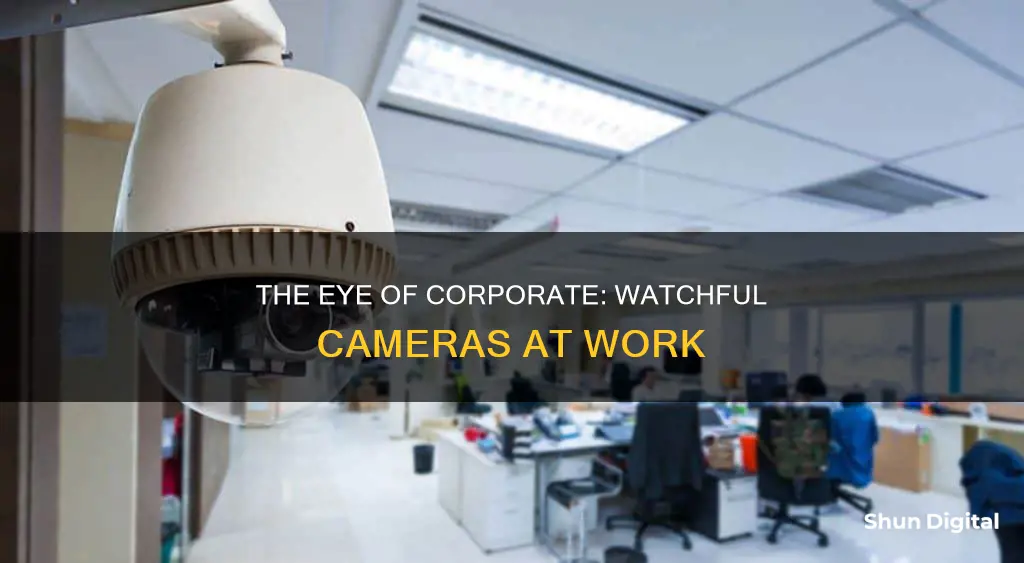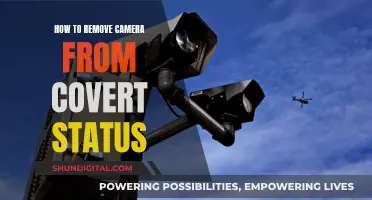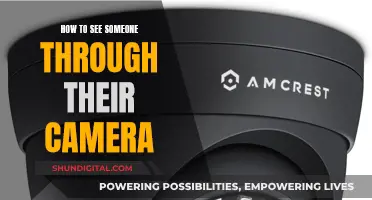
The use of corporate watch cameras, or workplace surveillance, is a highly debated topic with valid arguments on both sides. Proponents of workplace surveillance argue that it helps prevent theft, harassment, and vandalism, thus protecting both employers and employees. On the other hand, opponents raise concerns about privacy rights and the potential for surveillance to create a stressful and anxious environment for employees. While generally legal, the use of workplace surveillance is subject to varying state laws and the expectation of privacy in certain areas, such as restrooms and break rooms. The purpose of the surveillance is also a critical factor, with courts weighing the employer's need against the employee's right to privacy. As technology advances and becomes more invasive, the debate around corporate watch cameras will likely continue to evolve, challenging us to find a balance between security and privacy.
| Characteristics | Values |
|---|---|
| Purpose | Prevent theft, harassment, and vandalism |
| Legality | Generally legal, but depends on state law and employee privacy rights |
| Notification | Employees must be informed about the use of cameras in the workplace |
| Location | Public areas only; no bathrooms, locker rooms, or break rooms |
| Audio | Not usually allowed due to federal and state wiretapping laws |
| Union Activity | Employers cannot use video surveillance to monitor union activity |
What You'll Learn

Legality of corporate watch cameras
The legality of corporate watch cameras is a complex issue that varies depending on the region and specific circumstances. Here is an overview of the key considerations regarding the legality of corporate watch cameras:
Legitimate Business Purpose:
Corporate surveillance must serve a legitimate business purpose. This could include preventing theft, ensuring employee safety, monitoring employee performance, or complying with insurance requirements. Employers must demonstrate a valid reason for implementing surveillance cameras.
Notification and Consent:
In most cases, employers are legally required to notify their employees about the presence of security cameras. It is highly recommended to disclose the workplace surveillance policy, including camera locations, and obtain written confirmation of the employees' understanding and consent to be recorded.
Areas with Expectation of Privacy:
Surveillance cameras are generally prohibited in areas where individuals have a reasonable expectation of privacy. This includes restrooms, locker rooms, changing rooms, and employee lounges. Employers must respect their employees' privacy rights and refrain from installing cameras in these private spaces.
State and Federal Laws:
The legality of corporate watch cameras can vary from state to state in the US. While some states outlaw hidden cameras, others allow their use in specific circumstances. Additionally, federal laws, such as the National Labor Relations Act, prohibit employers from using video surveillance to monitor union activities.
Audio Surveillance:
Audio surveillance is subject to stricter regulations than video surveillance. Federal wiretap laws and state laws often prohibit the recording of audio conversations without the consent of all parties involved. Therefore, many corporate surveillance cameras do not capture audio to comply with these laws.
Employee Rights:
Employees have the right to privacy and can take legal action if they feel their privacy has been invaded. If employees believe their employer is engaging in unlawful surveillance practices, they can consult an employment lawyer to understand their rights and explore their legal options.
In conclusion, the legality of corporate watch cameras depends on a variety of factors, including the purpose of the surveillance, employee notification and consent, respect for privacy expectations, compliance with state and federal laws, and the protection of employee rights. It is essential for organizations to carefully consider these factors and seek legal advice when implementing surveillance cameras in the workplace.
Android Smartwatches: Camera-Equipped or Not?
You may want to see also

Preventing theft
Corporate spaces often contain valuable inventory, cash, and sensitive information, making them attractive targets for theft. To mitigate this risk, businesses can implement various measures, including installing watch cameras. These security cameras act as a deterrent and aid in detecting and investigating theft incidents. This article will discuss strategies for preventing theft in corporate spaces using watch cameras and provide detailed instructions for optimal effectiveness.
Strategies for Theft Prevention
- Visible Camera Placement: Place cameras in locations that are visible to potential thieves. This acts as a deterrent, as individuals are less likely to commit theft if they know they are being watched. Ensure cameras are installed at least nine feet above the ground to make them difficult to reach and tamper with.
- Vandal-Resistant Housing: Use heavy-duty metal or reinforced plastic housings for cameras to protect them from damage. The IK rating scale indicates the level of protection, with IK10 being the highest.
- Secure Wiring: Bury or protect wiring in metal conduits to make it harder for thieves to cut data transmission cables.
- Motion-Activated Lights: Install motion-activated lights near cameras to deter potential vandals or thieves.
- Uninterruptible Power Supplies (UPS): Use UPS for cameras to ensure they remain operational even during power outages or attempts to cut their power.
- Dummy Cameras: Install fake cameras to confuse and deter thieves, keeping them focused on neutralizing the dummy cameras while real ones monitor the premises.
- Signage: Display signs indicating that the area is under surveillance. This reinforces the deterrent effect and suggests the presence of multiple cameras.
- Remote Monitoring: Utilize cloud-based systems to remotely monitor footage and investigate incidents from anywhere, anytime.
- Video Analytics: Leverage AI-enhanced video analytics for automatic indexing of activities, facial recognition, license plate recognition, and unusual behavior detection. This accelerates investigations and enables quick resolution of incidents.
- Crystal Clear Video Quality: Opt for modern security cameras with high resolutions to capture fine details, ensuring a fuller context of incidents.
By implementing these strategies and utilizing modern smart camera technology, businesses can effectively prevent and mitigate theft in corporate spaces. It is important to stay updated with advancements in video surveillance technology to combat evolving security challenges and protect valuable assets.
Streaming Sites to Watch 5 Broken Cameras Documentary
You may want to see also

Protecting employees
Video surveillance systems can be a powerful tool for protecting employees in the workplace. Here are some key ways in which surveillance cameras can enhance employee security and well-being:
Preventing Theft and Vandalism
Video surveillance is an effective deterrent against theft and vandalism. By monitoring vulnerable areas, such as entrances, exits, and storage rooms, businesses can reduce the risk of internal theft and external intrusions. This not only protects the company's assets but also ensures that employees are not wrongfully accused or implicated in theft-related incidents.
Enhancing Staff Security
Surveillance cameras can protect employees from assaults, harassment, and battery on company premises. By monitoring visitors and recording suspicious activities, businesses can proactively safeguard their employees. Recorded footage can also serve as valuable evidence in police investigations and court proceedings, aiding in the pursuit of justice.
Resolving Workplace Conflict
Video surveillance can be leveraged to resolve disagreements and conflicts between employees or between employees and management. Reviewing unbiased camera footage can provide undeniable proof, leading to more efficient and fair conflict resolution. This can help maintain a harmonious and productive work environment.
Increasing Efficiency and Compliance
Surveillance systems can be used to analyze work environments and processes, identify gaps, and implement improvements. This can lead to a more efficient and less frustrating work experience for employees. Additionally, maintenance workers can utilize camera footage to identify equipment requiring repair or functioning hazardously, ensuring compliance with safety regulations.
Protecting Privacy
While video surveillance can enhance security and productivity, it is crucial to balance monitoring with employee privacy. Businesses should avoid placing cameras in areas with a reasonable expectation of privacy, such as restrooms and locker rooms. Transparency about the presence and purpose of cameras can alleviate employee concerns and build trust.
In summary, video surveillance, when implemented with careful consideration for privacy, can be a valuable tool for protecting employees' safety, resolving conflicts, and improving overall workplace efficiency and compliance.
Are School Cameras Watched?
You may want to see also

Privacy concerns
The use of corporate watch cameras in the workplace raises several privacy concerns for employees. While video surveillance systems can help prevent theft, harassment, and vandalism, they can also be seen as an invasion of privacy. Employees may feel uncomfortable being constantly monitored, especially if the cameras are placed in more private or secretive areas.
Transparency and Communication
To mitigate privacy concerns, employers should be transparent about the use of video surveillance and communicate the benefits of the system to their employees. It is important to notify workers about the presence of cameras and the areas under surveillance. This can help employees understand the legitimate business reasons for the cameras, such as security and theft prevention.
Reasonable Expectation of Privacy
However, there are certain areas where employees have a reasonable expectation of privacy, such as restrooms, locker rooms, and employee lounges. In some states, it is illegal to install surveillance equipment in these areas. For example, in California, it is a crime to install a surveillance mirror in a restroom or locker room. Similarly, in Connecticut, employers are prohibited from operating surveillance equipment in areas designated for employee rest and comfort.
Audio Recordings and Union Activity
Additionally, federal wiretap law prohibits the recording of certain oral communications without the consent of all parties involved. Therefore, most security cameras lack audio, as employers are typically required to obtain consent for audio recordings. Furthermore, employers are not allowed to use video surveillance to monitor union activity or intimidate current or prospective union members.
Impact on Employee Morale and Productivity
The constant monitoring of employees can also lead to increased stress, anxiety, and a sense of distrust between workers and employers. Some employees may feel pressured to be constantly productive and may avoid taking breaks, which can lead to burnout and lower engagement and productivity in the long run. Therefore, employers should be mindful of the potential impact of video surveillance on their employees' well-being and privacy rights.
Cameras: Always Watching, Always Listening?
You may want to see also

Surveillance in restricted areas
Legal Considerations
In the US, there are a number of laws and guidelines that govern the use of surveillance in restricted areas. The Federal Wiretap Law prohibits the recording of certain oral communications, which is why surveillance cameras typically do not have audio. The National Labor Relations Act prohibits the use of video surveillance to record union activities and meetings. The Electronic Communications Privacy Act also limits the use of cameras in certain places.
Implementation
When implementing surveillance in restricted areas, it is important to balance security needs with the privacy rights of employees and visitors. Organisations should ensure they have a clear policy on video surveillance and that all employees and visitors are notified of its use. It is generally recommended that cameras are placed in public and obvious locations, rather than in secretive places, to avoid privacy concerns.
Benefits
The use of surveillance in restricted areas can help to prevent theft and protect assets. It can also aid in resolving workplace conflicts, as footage can provide unbiased evidence to support investigations and conflict resolution. Surveillance can also be used to enhance staff security by monitoring and recording all visitors to a facility, thus protecting employees from potential assaults and harassment.
Drawbacks
However, there are also potential drawbacks to the use of surveillance in restricted areas. Employees may feel that their privacy is being invaded, particularly if cameras are placed in break rooms or other non-public areas. This can lead to increased stress and anxiety, and a sense of distrust between workers and employers.
Best Practices
To ensure effective and ethical surveillance in restricted areas, organisations should follow these best practices:
- Have a clear and lawful purpose for the surveillance, such as security or theft prevention.
- Notify all employees and visitors about the use of surveillance.
- Place cameras in public and obvious locations.
- Ensure the surveillance system is integrated with other security measures, such as access control systems.
- Use the system to analyse work environments and processes rather than individuals.
- Involve the HR department in the implementation and communication of the surveillance program.
- Regularly review and update the surveillance program to ensure it remains effective and compliant with any legal changes.
Can Principals Monitor Teachers Through Surveillance Cameras?
You may want to see also
Frequently asked questions
It is generally legal for employers to use video cameras in the workplace. However, there are limits on where cameras can be installed and the purposes they are used for.
Yes, employers must notify their employees about the use of cameras in the workplace.
No, it is a violation of federal labor law for employers to film or record union meetings or activities.
Yes, employers can use cameras to monitor employee productivity as long as they have a legitimate business reason and the employee has no reasonable expectation of privacy.
Yes, employees can exercise their right to sue if they feel that their privacy has been invaded by workplace cameras. They can also speak up if they feel that the cameras are placed in areas where they have a reasonable expectation of privacy.







